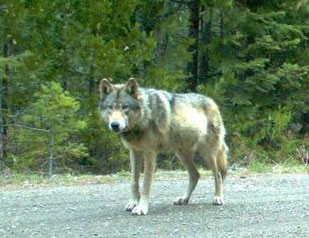While wildlife organizations struggle to help wolves under assault in Wyoming, Idaho and other states, there’s good news in California.
The state wildlife commission has protected wolves under the California’s Endangered Species Act – just in time for the first wolf pack to arrive in 90 years.
"There is no species more iconic in the American West than this one, the gray wolf," says commission president Michael Sutton. "We owe it to them to do everything we can to help them recolonize their historic range in this state." Hunters and ranchers pushed hard against it.
Wildlife advocates have been closely watching lone wolf OR7, which was spotted in northern California in 2011. Born in northeast Oregon – where wolves are protected under the state’s Endangered Species Act – OR7 has been tracked by radio collar over thousands of miles, criss-crossing the two states across deserts and mountains in search of a mate.
OR-7 was the 7th wolf in Oregon to receive a radio collar:

This year he found a mate and there are now two wolf pups about 8 weeks old – currently living near the border in Southern Oregon’s Rogue River-Siskiyou National Forest.

There’s plenty of great wolf habitat in Southern Oregon and North California, says the Center for Biological Diversity, which has been pushing for their protection since 2012.
"We know it won’t be long before the howl of wolves, silenced in California for nearly a century, will be heard there once more," they say.
In Oregon, there are 64 wolves in 8 packs, including 4 breeding pairs, up from 46 wolves in 6 packs with 6 breeding pairs in 2012.
Beyond Sadly, wildlife groups are fighting against US Fish & Wildlife Service (FWS) plans to delist wolves in all lower 48 states.
We’ve seen the result in the Rockies states, where 2,700 wolves have been slaughtered since 2011 – more than half the population. Why? A rider was slipped into the must-pass budget, removing wolves in those states from the Endangered Species List – the first time a species has ever been removed for political, not scientific reasons.
Idaho is offering $1000 bounty for every wolf killed. The state wants 500 more wolves dead, reducing the population to just 150 animals – the minimum before they go back on the federal Endangered Species List.
While FWS wants to halt protection for wolves, they are the very agency that restored the population. In 1995, they imported 14 wolves from Canada to Yellowstone National Park, and then seeded more across the Rocky Mountain states. They were successful and wolf populations had been blossoming until 2011, but still covered only 5% of their range.
Europe Protects Wolves
With great interest, we just learned that Europe is launching the EU Platform on Coexistence between People and Large Carnivores to facilitate a constructive dialogue among key stakeholders: farmers, hunters, landowners and conservationists. The goal is come to mutually agreeable solutions regarding conflicts with people living and working in close proximity to wolves, brown bears, wolverines and lynx.
Thanks to protective legislation such as the EU Habitats Directive, adopted 20 years ago, and Natura 2000, populations of these large animals have returned from the brink, growing to about 40,000 across Europe. Most populations are stable or increasing, returning to many areas where they have been absent for decades.
About 10,000 of the animals are wolves – way more than is left in the US.
Read our article, Wolves In the Cross Hairs, Can’t They Be Allowed to Exist?
Learn about wolves on the west coast:
